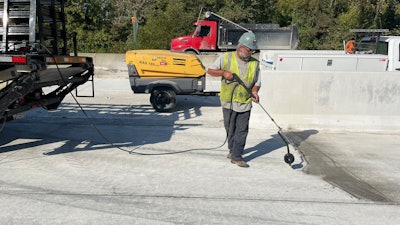
Concrete highways are a critical piece of infrastructure in the U.S., essential for the reliable transportation of people and products. Yet in many cases, their service life is restricted by the limited durability of saw-cut portland cement concrete pavement (PCCP) joints.
Repair and replacement of PCCP joints is a disruptive, expensive, and time-consuming process. Traditional damage and deterioration prevention strategies utilize either joint fill materials to keep fluid from entering the PCCP joints or coating products to create a barrier on the joint faces. Unfortunately, these solutions only offer 2-5 years of protection.
To address these durability problems, the Indiana Department of Transportation partnered with Purdue University and the Indiana Soybean Alliance to develop and road test soy methyl ester-polystyrene (SME-PS) as a solution. Now branded as PoreShield, SME-PS concrete durability enhancers are a new and innovative alternative to these short-term joint treatments.  Workers spray PoreShield on Indiana's I-65.PoreShield
Workers spray PoreShield on Indiana's I-65.PoreShield
Designed to protect concrete from premature deterioration, PoreShield SME-PS-based products actually protect concrete from the inside out and are not susceptible to abrasion or weathering at the surface. Applied topically, PoreShield absorbs deep into the saw-cut and creates a fluid, hydrophobic barrier inside the pore network of concrete surrounding PCCP joints. Once absorbed into the concrete pores, PoreShield blocks fluid and ion ingress and provides long-lasting concrete protection with a single application. Since it does not set or cure, PoreShield continuously self-seals and adjusts to new damage as it occurs, providing enhanced concrete durability for 10 or more years.
Proven Performance
In many climates throughout the U.S. concrete highways are vulnerable to deterioration mechanisms that result from winter and the corresponding deicing treatments (i.e. NaCl, CaCl2, and MgCl2) meant to keep roads in a safe, working condition through snow and ice events. These deterioration mechanisms include expansive pressure caused by freeze/thaw cycles as well as salt crystallization damage and chemical deterioration mechanisms, such as calcium oxychloride formation.
More than a decade of research and testing demonstrates that PoreShield offers superior protection against these hazards. In fact, a 2022 study out of Drexel University found that PoreShield reduces calcium oxychloride formation in concrete by more than 90% (He et al., 2022).  Wisconsin Department of Transportation | PoreShield
Wisconsin Department of Transportation | PoreShield
In addition, a 2020 study sponsored by the Wisconsin Department of Transportation concluded that PoreShield reduced chloride ion diffusion by twice as much as other leading products, preventing both short- and long-term damage to concrete. The independent study also determined that PoreShield SME-PS extends the service life of PCCP joints 5.4 to 9 times longer, compared to untreated concrete.
DOT Adoption & Application
In real-world applications, applicators have been impressed with the ease and safety of PoreShield SME-PS products. The technology is low VOC (43.3 g/L), requires no PPE for application and can be sprayed into PCCP joints using traditional equipment without any modifications.
- Joe Thomas, vice president of operations at Primco Inc. applied PoreShield to saw cut joints on the free-flow ramp interchange of US 24 and I-469 near Fort Wayne, Indiana in late 2019. As quoted in a testimonial interview, “PoreShield helps us in our day-to-day job because it’s quick and easy to use. We don’t have the cleanup that we would have had with a silicone-based material,” says Thomas.
- In 2020, Tony Korba, concrete operations manager at E&B Paving, applied PoreShield to 14 miles of PCCP joints on I-65 near Seymour, Indiana. He used a recreational vehicle with a tank, a pump, and two hoses to allow two workers to apply PoreShield at the same time. Regarding the application, Korba observed that “it was basically as fast as you could walk. The speed of the application was just unbelievable compared to a sealant.”
- Following the application to I-65, the Indiana Department of Transportation published a unique special provision specifying “soy-based penetrating sealers for PCC joints.” Now, INDOT is writing these PoreShield SME-PS-based products into a Design Manual Spec, which specifies them for use as a general part of PCCP design.
- PoreShield SME-PS is also being specified by the city of Sioux Falls, South Dakota on new paving bids following a successful application in 2021. More DOTs across the U.S. are expected to follow suit as they learn about and trial PoreShield SME-PS-based products.
About the author
Paul Imbrock is the PoreShield Technical Lead for the Indiana Soybean Alliance.


















